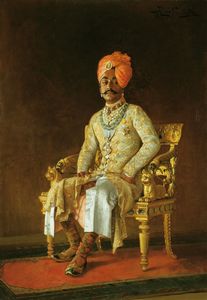Marwar Dynasty takeover
In 1729, Anand Singh and Rai Singh, brothers of the Maharaja of Jodhpur, captured Idar by force. They captured the districts of Idar, Ahmednagar, Morasa, Baad, Harsol, Parantij and Vizapur. Five other districts were made tributaries of their new state. The state was soon annexed by the Marathas under Damaji Gaekwad in 1753 and Anand Singh was killed in battle. When Rai Singh got to know about his brother's death he gathered a force and once again captured Idar; he placed Anand Singh's son on the throne and became his guardian. After Rai Singh's death in 1766, the Marathas once again threatened Idar upon which Rao Seo Sinh, son of Anand Singh, agreed to hand over the districts of Parantij and Vizapur to the Peshwa and Morasa, Baad and Harsol to the Gaekwads. [5]
In 1875, Idar state had a revenue of £60,000 and paid a tribute of £3,034 to the Gaekwads of Baroda State. The population of the state in 1875 was 217,382. The rulers were Rathore Rajputs of the Joda family and were entitled to a gun salute of 15 guns. [6]
In 1924, Idar was made part of the Western India States Agency. It was transferred to the Rajputana Agency in the early 1940s. On 10 June 1948, Idar became part of the Indian Union. In 1949, it was dissolved and split between Sabar Kantha district and Mehsana district, which were at that point in Bombay State. [7] Both districts were included in Gujarat when it was formed in 1960.






